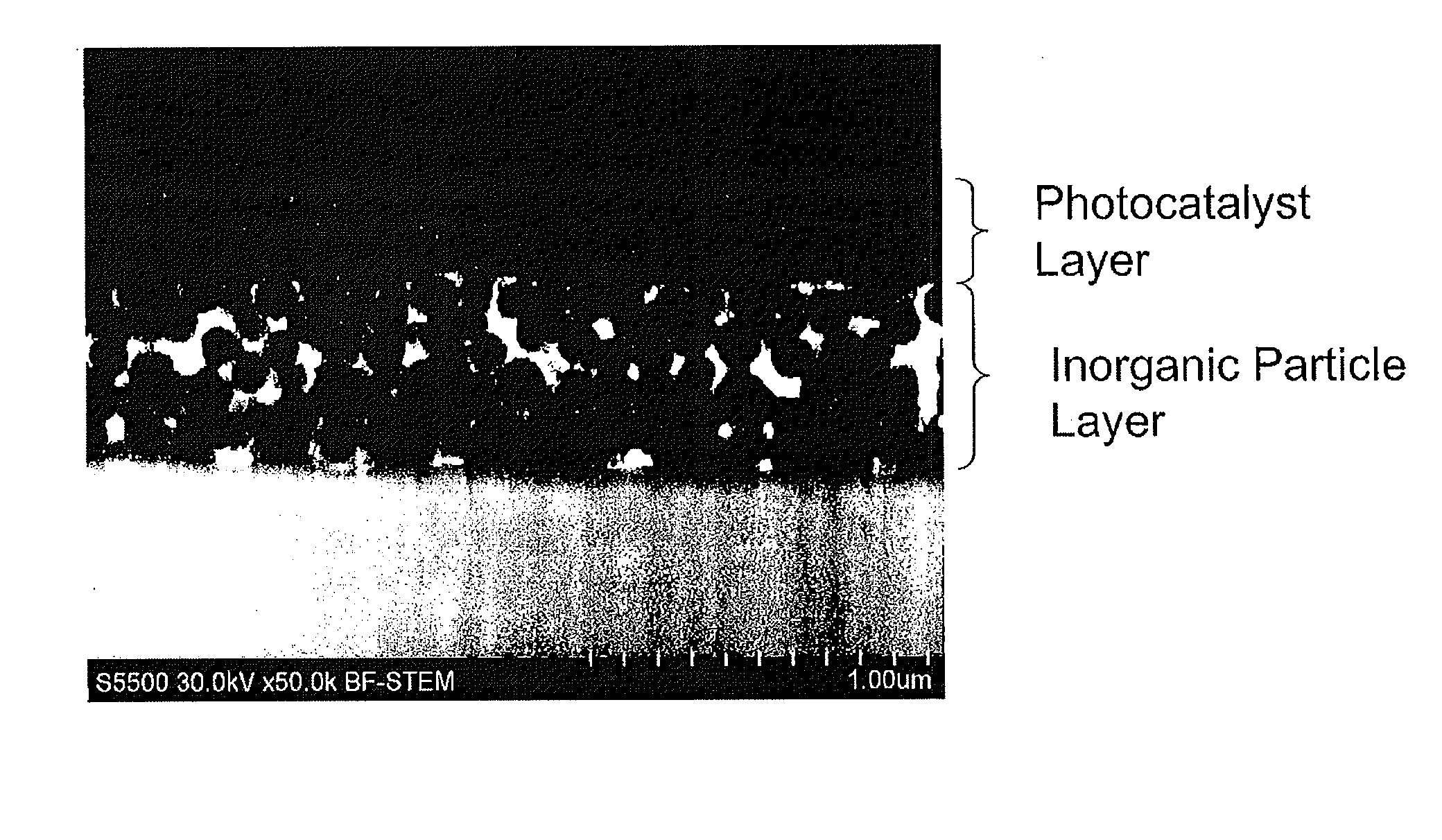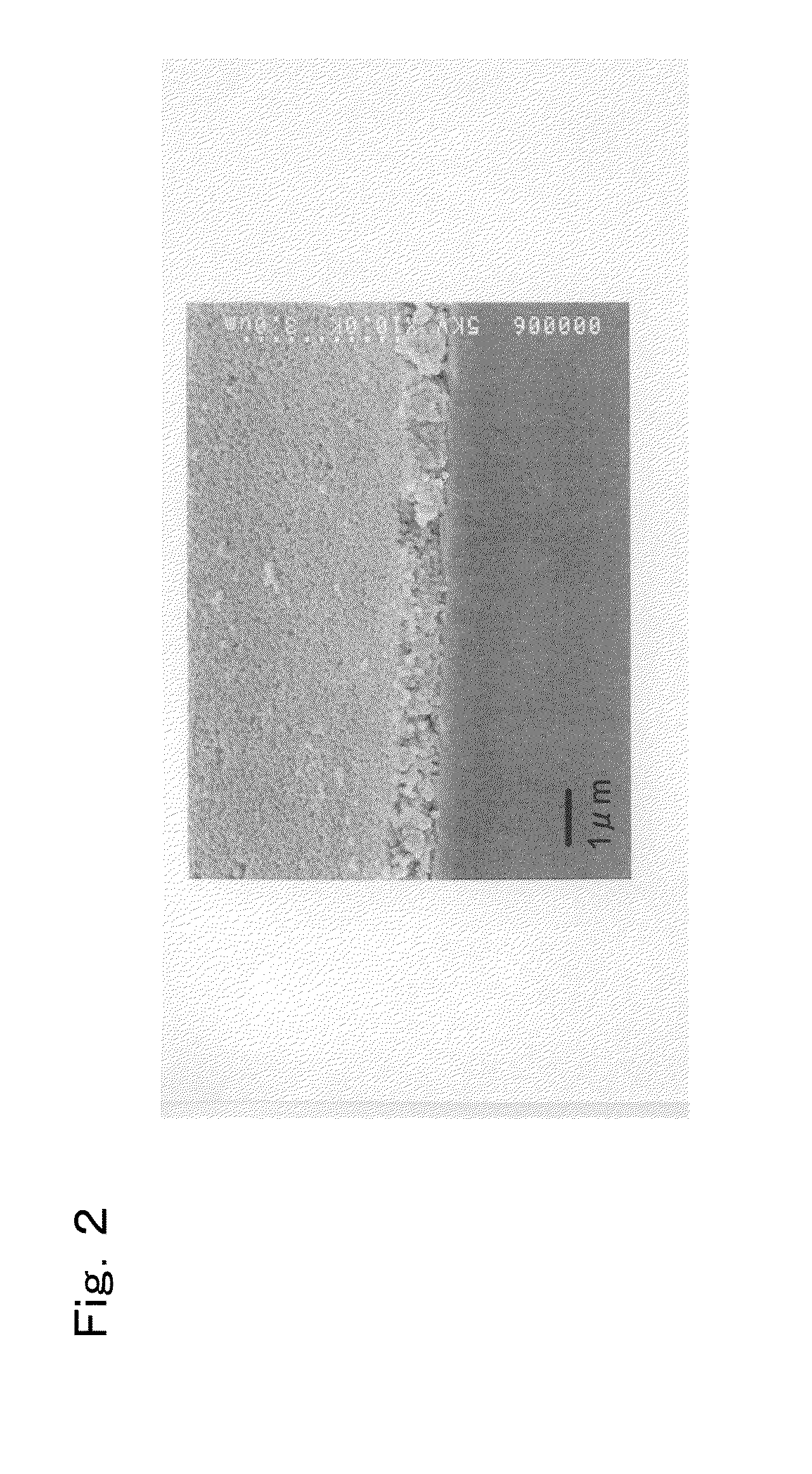Photocatalyst composite and photocatalytic functional product using the same
- Summary
- Abstract
- Description
- Claims
- Application Information
AI Technical Summary
Benefits of technology
Problems solved by technology
Method used
Image
Examples
example 1
Photocatalyst Dispersion
[0128]To 4 kg of ion-exchange water as a dispersion medium, 1 kg of tungsten oxide particles (manufactured by NIPPON INORGANIC COLOUR & CHEMICAL CO., LTD.) were added, followed by mixing to obtain a mixture. The obtained mixture was subjected to a dispersion treatment under the following conditions using a wet media agitation mill [“Ultra Apex Mill UAM-1”, manufactured by Kotobuki Engineering & Manufacturing Co., Ltd.] to obtain a tungsten oxide particle dispersion.
[0129]Milling media: 1.85 kg of zirconia beads having a diameter of 0.05 mm
[0130]Stirring speed: peripheral speed of 12.6 m / seconds
[0131]Flow rate: 0.25 L / minute
[0132]Treating time: about 50 minutes
[0133]The average particle diameter of tungsten oxide particles in the obtained tungsten oxide particle dispersion was 118 nm. One portion of the dispersion was vacuum-dried to obtain the solid part. As a result, the BET specific surface area of the obtained solid part was 40 m2 / g. The mixture before the...
example 2
[0146]In the same manner as in Example 1, except that the temperature of the primary compression when producing the inorganic particle composite 1 in Example 1 was controlled to 150° C., an inorganic particle composite was obtained. The SEM micrograph of the inorganic particle composite is shown in FIG. 4. The surface of the inorganic particle composite was mainly composed of only the inorganic particle layer, but polypropylene was observed at one portion. The pencil hardness of the surface of the inorganic particle composite is shown in Table 1.
[0147]Next, in the same manner as in Example 1, a photocatalyst composite was obtained. The adhesion of the photocatalyst layer of the photocatalyst composite is shown in Table 1.
example 3
Photocatalyst Coating Solution 2
[0155]To a solution prepared by mixing 26 g of a high-purity ethyl ortho-silicate (manufactured by TAMA CHEMICALS CO., LTD.) with 120 g of ethanol, 193 g of water was added, followed by mixing under stirring. Furthermore, 61 g of colloidal silica (manufactured by Nissan Chemical Industries, Ltd., STOS: 20.4% by mass) was added, followed by stirring to obtain a binder for a photocatalyst layer.
[0156]To 80 g of the obtained binder for a photocatalyst layer, 320 g of the photocatalyst dispersion obtained in Example 1 was added to obtain a photocatalyst coating solution 2.
(Production of Inorganic Particle Structure 2)
[0157]Using a film (melting point: 260° C., thickness: 100 μm) made of polyethylene terephthalate as a solid material, a coating solution for formation of an inorganic particle layer, that is the same as that in Example 1, was coated on the surface of the film using a microgravure roll (manufactured by Yasui Seiki Co., 230 mesh) followed by d...
PUM
| Property | Measurement | Unit |
|---|---|---|
| Temperature | aaaaa | aaaaa |
| Temperature | aaaaa | aaaaa |
| Temperature | aaaaa | aaaaa |
Abstract
Description
Claims
Application Information
 Login to View More
Login to View More - R&D
- Intellectual Property
- Life Sciences
- Materials
- Tech Scout
- Unparalleled Data Quality
- Higher Quality Content
- 60% Fewer Hallucinations
Browse by: Latest US Patents, China's latest patents, Technical Efficacy Thesaurus, Application Domain, Technology Topic, Popular Technical Reports.
© 2025 PatSnap. All rights reserved.Legal|Privacy policy|Modern Slavery Act Transparency Statement|Sitemap|About US| Contact US: help@patsnap.com



